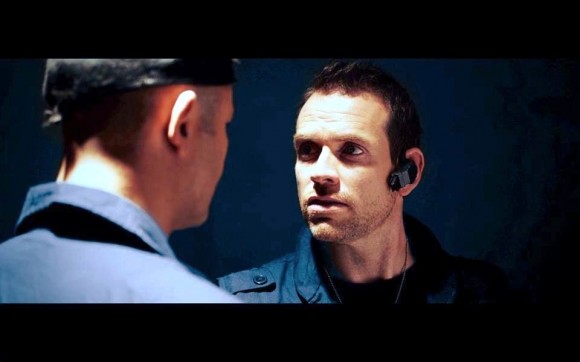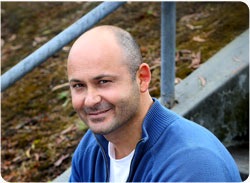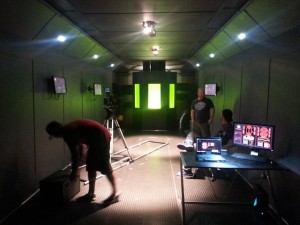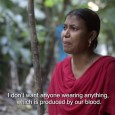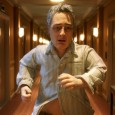It’s mid afternoon and the scent of freshly painted walls fills the air. Cylinders of brightly coloured fluid in all the colours of the rainbow are arranged along the steel grey walls, telling you this is no ordinary shed. A couple of guys in military black jaunty berets packing some serious weaponry add to the scene. They are gathered together, perhaps talking tactics, and one is clearly the leader. Unexpectedly a cinematographer wanders into view.
This is definitely no ordinary parking lot in Pyrmont but it could be a pointer to the future of independent filmmaking.
When you think of Australian filmmaking many questions spring to mind: what stories do we tell and what stories do the public want to see? Are these compatible? Box office receipts seem to suggest there is a disconnect between the two.
Up-and-coming Aussie filmmaker Tim Boyle wants to change that. He is currently shooting his fourth feature film, enticingly titled The Half Dead, using digital technology.
This affordable and accessible technology has allowed filmmakers like Tim to make micro budget films to compete with big-budget foreign films and to tell the stories they want to tell. As writer, director, producer and actor Tim has complete control.
And for a self-funded independent film with little or no budget, the entrepreneurial filmmaker has managed to attract an experienced cast including widely respected Welsh actor John Rhys-Davies, star of The Lord of the Rings trilogy and the Indiana Jones movies. Well-known Australian actors Tamson Walton, wife of Rove McManus, Jay Laga’aia and Steve Bastoni are also starring in The Half Dead, a science fiction thriller that tells the tale of a woman who 15 years after a near-fatal car crash wakes up in a psychiatric hospital with a new-found psychic ability to see auras.
I sat down with Tim recently to talk about his career, the Australian film industry and the future of filmmaking in Australia. Tim, sporting his obligatory five o’clock shadow, strides into the room purposefully. He is a man who knows what he wants and how to get there.
His filmmaking journey began at age 9, when while watching a special features documentary on the making of Ghostbusters, he had a creative epiphany.
“I saw the camera moving and I understood the connection between the camera moving and that shot.”
This moment ignited his life-long passion for filmmaking.
And it’s this passion that he has drawn on to keep shooting away, hoping to attract enough attention and funding to allow him to continue making movies.
Almost every Australian feature film is government-funded and most tell uniquely Australian stories. Often they are critically successful but still fail to attract the cinema-going public. Tim believes the Australian film industry is in some difficulty because we don’t make movies that people want to see. He says he doesn’t approach funding bodies such as Screen Australia “as there are too many hoops to jump through, and they prefer Australian stories”.
As a writer Tim believes Australian stories are important and quotes from the iconic Australian play Emerald City: “If we don’t tell stories that are Australian then we will believe life is lived somewhere else.”
But the biggest movie at the box office this year is the 3D blockbuster Iron Man 3 with its $100 million budget. The rest of the top ten are largely action films – popcorn films that are slammed by the critics but loved by the public.
Tim is trying to compete with these films and passionately defends his choice to make a film for Americans shot with American accents.
“I’m doing a genre film. I’m doing a Matrix; I’m doing an XMen. If I did that as an Australian thing the Americans would look at it and go ‘wow that’s pretty cool for an Australian thing but I’m not going to watch it,’ whereas if they think it’s an American film they will drop their $6 bucks and watch it and go that was cool or that was not cool.”
In support of Tim’s strategy are the cold hard facts of Australian filmmaking: since 1992, only 11 Australian films have made it into the box office top 10.
Digital technology has paved the way for micro-budget films to compete with the bigger budget foreign and government films. CGI and postproduction digital technology is available to people like Tim to make a science fiction tale on a micro budget.
Critics may say it’s an ambitious and impossible task but remember that Mad Max was also a genre film, independently financed by the filmmakers with some unknown stars. An international success, it held the record as the world’s most profitable film for years. It also thrust director George Miller and actor Mel Gibson, both unknowns, into the glamorous glitzy world of Hollywood.
Tim is passionate about filmmaking, a necessary quality to survive in this competitive and highly risky industry. It’s this energy and belief that has attracted the cast to his film.
This fearless determination and tenacity enabled Tim to have the bravado to approach John Rhys-Davies during his Australian visit to promote the release of the Indiana Jones movies on BluRay. Tim told him about his film at a PR function.
“You could see the guys from Paramount behind him putting their hands on their heads going ‘please stop trying to push your film onto our star that we’ve brought to talk about Indiana Jones’,” the Aussie filmmaker recalls.
But the conversation yielded results and in a coup for independent film making, Rhys-Davies has generously given his time for a small but pivotal role in The Half Dead.
“You Australians don’t realise how much strength and depth you have in your acting and filmmaking,” Rhys-Davies said in those dulcet tones that command respect and attention, praising the talents of director Tim Boyle.
“So what I hope we’ve got here is a big studio film look from a bunch of young and very gifted filmmakers that will do well at the box office and that will reflect well on everyone concerned.
“You have to take a leap of faith with these things and, fingers crossed, I think we’ve got a winner here. As often as not, big studios can spend $150 million and do less than what energy, passion and creativity can provide on very little.”
So is working with such an experienced actor who has worked under the direction of movie legends Steven Spielberg and Peter Jackson a camera shaking experience? Not for Tim who is confident in his abilities as a writer and director. “It’s the fourth film, I’ve made. I’ve been around long enough, I know what I’m doing.”
And his track record backs up his claim: Tim made his first film in 1998 and has cast, before they were famous, actors Sam Worthington of Avatar fame and Yvonne Strahovski who went on to TV and film success in the US.
It was through his friendship with Sam Worthington that Tim met another mega star of film, academy award-winning director James Cameron. At a party in Hollywood with Sam Worthington, Tim was chatting with Cameron about his career when the director of Titanic and Avatar gave him a valuable tip.
“Tim I’m going to give you advice that Walter Hill gave me,” Cameron said to him.
Keeping in mind that Walker Hill was the great 1970s director of Warriors and Brewster’s Millions, and the producer of Alien, Tim listened intently.
“Firstly, James Cameron is talking to me and secondly he is giving me the advice Walter Hill gave him,” Tim says. “He leans in, puts his hand on my shoulder and says, ‘Don’t fuck it up’. And I thought it was just great advice.”
Sam Worthington, known to friends as Wortho, came up to Tim afterwards and asked what he and Cameron has discussed in what seemed a long conversation.
“He gave me great advice,” Tim replied.
“What did he tell you?” Worthington asked.
“Don’t fuck it up.”
“He tells everyone that.”
“But he told me that; he told me that,” Tim concluded.
Independent filmmaking requires tenacity, self belief and quick-on-your-feet problem solving. But it’s the “don’t fuck it up” advice that plays on a loop in Tim’s mind when working with Rhys-Davies.
First day of filming and his crew are still constructing the set. Rhys–Davies is in the car on his way to the location when Tim gets a photograph of the set. A ‘70s porn film is the first thought that enters his mind, quickly followed by Cameron’s words.
“This is the end of my career. I cannot do this. I. Can. Not .Do. It.”
It’s an hour before they start filming and Tim is also driving towards the location, adrenaline pumping as he looks out of his window and sees the Olympic Stadium. Perhaps inspired by the gold medal winning feats of many Australians, Tim decides to check it out. The first hotel he sees, he pulls over, gets out and strides into the lobby. He scopes the lobby through the lens of a filmmaker.
“I can shoot here; this is beautiful,” he thinks.
Using his well-groomed Hollywood charms Tim gains approval. An hour later Rhys-Davies’ charismatic English tones are resonating through the lobby of the Pullman Hotel, Olympic Park, under the direction of Tim Boyle.
Having nailed this dilemma the next problem on the agenda is distribution, but new media has opened up ways that help independent filmmakers bypass the gatekeeper role of the big studios.
Queensland academic Greg Hearn, who studies creative industries, explains that Facebook, Twitter, YouTube, blogs and websites allow filmmakers to build a relationship with audiences before, during and after production.
“Many filmmakers progressively develop a fan base for their movie via Facebook, during development, production and post-production, by posting teaser trailers, interviews with filmmakers, and blogs about the filmmaking process,” he says.
Tim follows this model. He updates his fans via Facebook and Twitter and even uses Facebook to put out the call for extras to appear in his movie.
Another emerging option for filmmakers is online distribution through companies such as Netflix or ITunes. Foxtel also, through its movie channels, airs independent films on a pay-for-view basis prior to mainstream DVD release.
Dave Grohl’s documentary Sound City was released in Australia using this model. Tim is considering these options particularly for the American market. With a population of over 300 million the potential to make a significant profit through online distribution is very tempting.
“Although everybody is saying it looks good enough to go to the cinema. I’ve got sales agents who want to take it to the cinema,” he says.
Lunch over, Tim returns to the Pyrmont parking lot where his loyal crew are reconstructing the shed in preparation for the next day’s scenes. As he drives away I can’t help admire his creativity and drive. With a smile I watch his little red sports car, so very Hollywood, enter the traffic; his number plate ECTO 1. Movie buffs will know this is the Ghostbusters’ car.

